Uzbekistan
Things to DO
Bukhara
When the Arabs arrived in 709 AD, they found an already prosperous trading centre. Although they succeeded in Islamicising much of what
they controled, they faced almost continuous revolts and soon lost their enthusiasm for the place.
It was as capital of the Samanid state in the 9th and 10th centuries that Bukhara blossomed as Central Asia's religious and cultural
heart and simultaneously brightened with the Persian love of art.
After two centuries under the smaller Karakhan and Karakitay dynasties, Bukhara succumbed in 1220 to Genghis Khan and
in 1370 fell under the shadow of Timur's Samarkand.
A second lease of life came in the 16th century when the Uzbek Shaybanids made it the capital of what came to be known as the
Bukhara Khanate, which eventually embraced most of present-day Central Asia and parts of Iran and Afghanistan. The old town's
present appearance owes most to that period, especially to the greatest of the Shaybanid khans, Abdullah II (ruled 1583-98).
Under the Astrakhanid dynasty the Silk Road's decline slowly pushed Bukhara out of the Mainstream.
Then in 1753 Mohammed Rahim, the local deputy of a Persian ruler, proclaimed himself emir, founding the Mangit dynasty that
was to rule until the Bolsheviks came. In a parody of its ancient glory, Bukhara had a final fling as a decadent, feudal city-state, one
of three (whith Khiva and Kokand) that by this time dominated Central Asia and spent their time picking fights with one another.
The worst of the depraved Bukhara emirs was probably Nasrullah Khan who ascended the trone in 1826 by killing off his brothers
and 28 other relatives. He made himself a household word in Victorian England after the executed two Brithis officers;
Stoddart & Conolly
In 1868, Russian troops under General Kaufman occupied Samarkand and soon afterwards Bukhara surrendered and was made a protectorate of
the tsar, with the emirs still nominally in charge. It was finally incorporated into the Soviet Union in 1924
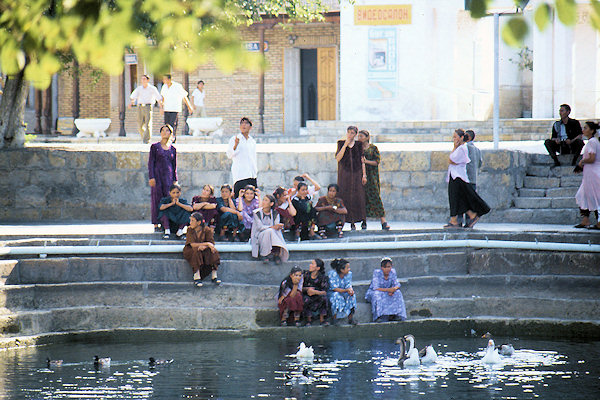 |
|||||
Lyab-i Hauz; a plaza built around a pool in 1620 is the most peaceful and interesting spot in town - shaded by mulberry trees
as old as the pool and peopled with street-sellers, crazies, old men hunched over chess-boards or gossiping over tea and anyone else
with nowhere else to go.
On the east side is a statue of Hoja Nasruddin, a semi-mythical "wise fool" who appears
in Sufi teaching-tales around the world.
The Nadir Divan-begi khanqah is a sufi lodge, or retreat, located at the west end of the Lyab-i Hauz ensemble. It was established
in the 1620s by vizier Nadir Divan-begi, the maternal uncle of Imam Quli Khan, the ruler of Bukhara from 1611-41.
North across the street, the Kukeldash Medrasa, was constructed in the late 1560s by Qul Baba Kukeldash, an emir under the Shaybanid
ruler Abdullah Khan II. It was at that time the biggest Islamic school in Central Asia.
From Shaybanid times, the area west and north from the plaza was a vast warren of market lanes and crossroad mini-bazars ("Tims")
whose multidomed roofs were designed to draw in cool air.
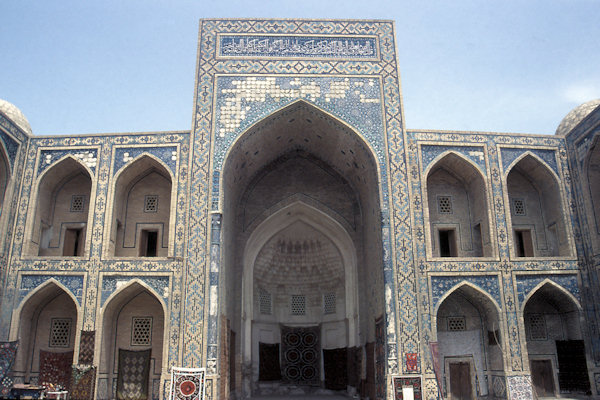 |
|||||
Ulugh Bek Madrasa was found in 1417 is the first Madrasa, built by Ulug Bek; the astronomer-king and grandson of Timur who
ruled from 1447-49.
When it was built by the Karakhan ruler Arslan Khan in 1127, the Kalon Minaret was probably the tallest building in Central
Asia. It's an incredible piece of work, 47m tall with 10m-deep foundations, which in 850 years has never needed any but cosmetic repairs.
Genghis Khan was so dumbfounded by it that he ordered it spared.
At the foot of the minaret is the 16th century congregational Kalon Mosque, big enough for 10.000 people. Used in Soviet times as
a warehouse, it was reopened as a place of worship in 1991.
Opposite, its luminous blue domes in sharp contrast to the surrounding brown, is the Mir-i-Arab Madrasa. It was constructed by the
Shaybanid ruler Ubaydullah-khan (r. 1534-39) who was the first of the Shaybanids to make Bukhara his primary capital.
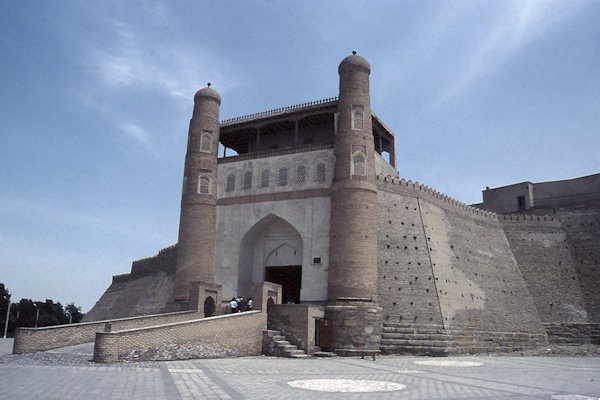 |
|||||
The spectacular-looking Ark, a royal town-within-a-town, is Bukhara’s oldest structure, occupied from the 5th century right up
until 1920, when it was bombed by the Red Army. For centuries it was the residence of the emirs of Bukhara.
It’s about 80% ruins but there
are still some remaining royal quarters, now housing several interesting museums.
Second on the left is the oldest surviving part of the Ark, the vast Reception and Coronation Court, whose roof fell in during the
1920 bombardment. The last coronation to take place here was Alim Khan’s in 1910.
The submerged chamber on the right wall was the treasury and mint, and behind this was the harem.
Behind the ark is the Zindon, the jail, now a museum.
Cheerful attractions include a torture chamber and several dungeons, including the gruesome "Bug Pit"; a dark chamber filled with
lice, scorpions and other vermin.
Beside a pool opposite the Ark's gate is the Bolo Hauz Mosque, the emir's official place of worship, built in 1718 and probably
very beautiful at that time. The brightly painted porch, supported by 20 columns of walnut, elm and poplar was added in 1917, as was the
stubby minaret nearby.
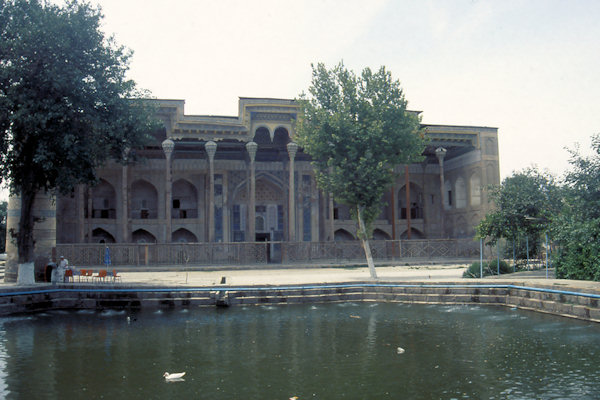 |
|||||
In Samani Park is one of the town's oldest monument (completed about 905 AD) and one of the most elegant structures in Central Asia,
the Mausoleum of Ismail Samani (the Samanid dynasty's founder), his father and grandson.
Behind the park is one of the few remaining, eroded sections of the Shaybanid town walls and a reconstructed gate called Tallipach.
The Chor Minor (literally, "four towers"), was founded by a Turkish merchant, Khalifa Niyaz Qouli in 1807.
The purpose of the building is not entirely clear, but it likely served as the forepart of a spacious madrasa which no longer survives.
Fayzulla Khodjaev (1896-1938), the scion of a wealthy family of karakul sheep traders whose short life spanned momentous changes
in Bukhara. Fayzulla worked closely with Russia to bring about change and was, in return for support given to the Red Army in their 1920
invasion of Bukhara, rewarded with the leadership of the newly-create Bukharan People's Soviet Republic.
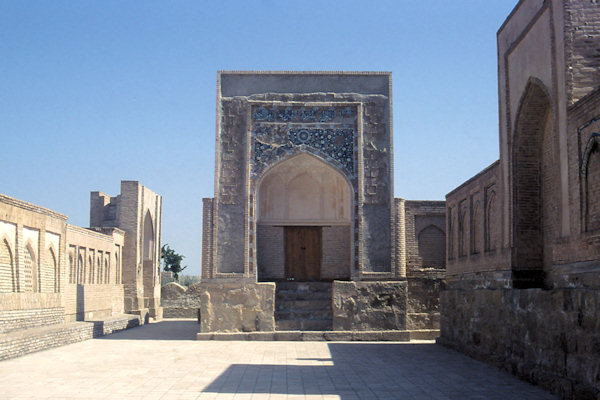 |
|||||
The memorial complex of Chor-Bakr (10km west of Bokhara) was built over the burial place of Abu-Bakr-Said (970-971 AD), and
who was one of the four of Abu-Bakrs (Chor-Bakr) - descendants of Muhammad.
The complex includes the necropolis of family tombs, and courtyards enclosed with walls.
The site became a popular location for ceremonies and prayers in the 16th century. However, it started to lose importance in the 19th century.
After the end of the Soviet era in Uzbekistan, the site increased in importance for Muslim pilgrimage and is considered necessary for
Muslim Uzbeks before their pilgrimage to Mecca.
Just 14km east of Bukhara is one of Sufism's more important shrines, the birthplace and the tomb of Bakhouddin Naqshband (1318–1389),
the founder of the most influential of many ancient Sufi orders in Central Asia.
The hudge dome of the complex covers a 16th century khanaka. To the west, in separate courtyard there is the large necropolis, where
Naqshbandi is buried. Graves of his mother and his teacher - Said Mir Kulol, are situated not far from his grave.
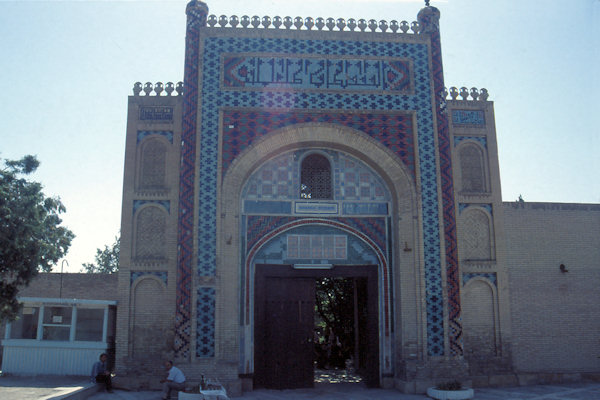 |
|||||
For a look at the kitsch lifestyle of the last emir, Alim Khan go out to Sitorai Mokhi-Khosa Palace (meaning
"Palace of Moon-like Stars" - his summer palace 3 km north of Bukhara.
The present buildings were a joint effort for Alim Khan by Russian architects (outside) and local artisans (inside). A 50 watt Russian
generator provided the first electricity the emirate had ever seen.
The palace is a fascinating mix of taste ans tastelessness - there's a fine collection of Asian porcelain displayed in a room with
heart-shaped windows.
Next door is the former harem and beside a pool where the woman frolicked is a wooden pavilion from which - says every tour guide -
the emir tossed an apple to his chosen bedmate.
The harem has a small museum devoted to the traditional silk-on-cotton dowry needlework called "suzani".